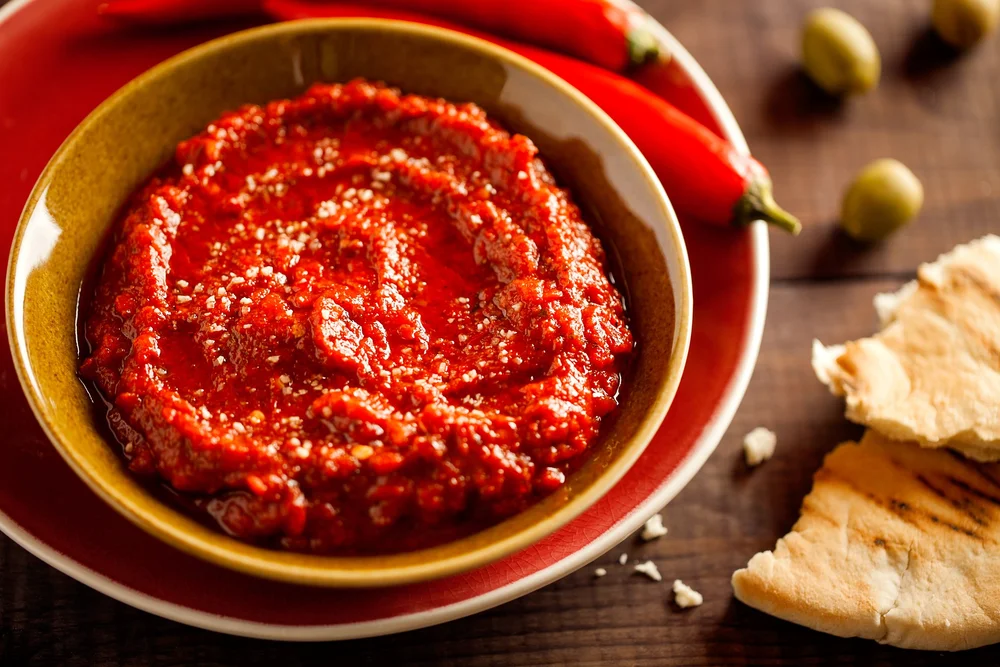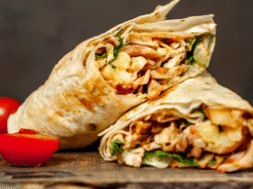Harissa: Tunisia’s Fiery Heartbeat
Harissa is more than just a condiment in Tunisia — it’s a way of life. This fiery chili paste, made from dried red peppers, garlic, olive oil, and spices, finds its way into nearly every meal. It’s smeared onto fresh bread, stirred into couscous, spooned over fish, or blended into marinades. For Tunisians, harissa isn’t just about heat — it’s about flavour, depth, and identity.
We first encountered harissa at a small market in Monastir. A vendor handed us a piece of warm bread dipped in bright red paste glistening with olive oil. The first bite was intense — smoky, spicy, and earthy all at once — but it was also addictive. It was clear why every Tunisian table has a jar within arm’s reach.
Harissa has ancient roots, born out of Tunisia’s love of spice and preservation. Families make large batches during chili season, drying peppers in the sun before grinding them with garlic, cumin, and caraway. Stored under a protective layer of olive oil, it lasts for weeks, feeding households through winter.
Each family recipe is slightly different. Some use more cumin, others more garlic, some keep it smoky, others bright with lemon. What unites them is the ritual: harissa is shared at the table, connecting generations with the same fiery spoonful.

Is Harissa Tunisian or Moroccan?
Harissa originated in Tunisia and is considered one of its national flavours. While it’s now popular across North Africa and the Middle East (and often associated with Morocco abroad), Tunisians proudly claim it as their own.
What is Harissa made of?
Traditional harissa is made from dried red chilies, garlic, olive oil, cumin, coriander, caraway, and salt. Some recipes add lemon juice for brightness or roasted chilies for smokiness.
How spicy is Tunisian Harissa?
Harissa is spicy, but not overwhelmingly so. Its heat is balanced with earthy spices and olive oil, making it flavourful rather than just fiery. Spice levels vary depending on the peppers used.
How do Tunisians eat Harissa?
Harissa is eaten daily in Tunisia. Common uses include:
- Spread on bread with olive oil as a starter
- Stirred into couscous or stews for depth
- Served alongside grilled fish or meat
- Mixed into sandwiches like kaskrout or fricassé
Is Harissa healthy?
Yes! Harissa is made from natural ingredients — chilies rich in vitamin C, garlic with immune-boosting properties, and heart-healthy olive oil. It’s low in calories and high in flavour, making it a healthy way to spice up meals.
Can you make Harissa at home?
Absolutely. Homemade harissa is easy and often more flavourful than store-bought. By soaking dried chilies, blending them with garlic, spices, and olive oil, you can make a fresh batch in under an hour.
Share this recipe
Harissa (Traditional Tunisian Chili Paste)

NUTRITION
Ingredients
- 12 –15 dried red chilies such as guajillo, ancho, or Tunisian baklouti peppers
- 3 cloves garlic
- 1 tsp ground cumin
- 1 tsp ground coriander
- 1 tsp caraway seeds lightly toasted
- ½ tsp salt
- 3 tbsp olive oil plus extra for preserving
- Juice of ½ lemon optional, for brightness
Instructions
- Soften the chilies: Remove stems and seeds from the dried chilies. Place them in a bowl of hot water and soak for 30 minutes until soft. Drain well.
- Blend the paste: In a food processor (or mortar and pestle for traditional method), combine softened chilies, garlic, cumin, coriander, caraway, and salt. Blend until smooth.
- Add olive oil: Drizzle in olive oil while blending to form a thick, rich paste. Add lemon juice if desired for extra freshness.
- Store: Transfer to a sterilized jar, smoothing the top. Pour a thin layer of olive oil over the surface to preserve. Store in the fridge for up to 3 weeks.




